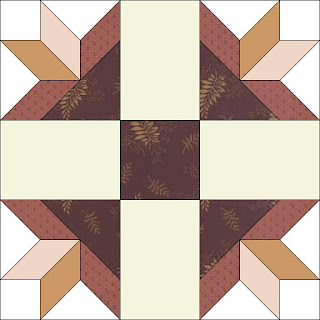Westering Women Block 9: Sage Bud by Denniele Bohannon
A small city grew up around Fort Laramie where travelers could buy supplies, trade with natives camped around the fort and rest for several days.

Westering Women Block 9: Sage Bud by Becky Brown
"My sage bud is in full bloom. I did additional reading to learn a little more about sagebrush - it is the state flower of Nevada (Wyoming's is the Indian Paintbrush)."
Interactive map from
Note Ft.Laramie (the red star on the trail) is located far northeast of today’s city of Laramie.Today it’s a National Historic Site off U.S. Highway 26, 3 miles from the town of Fort Laramie.
"August, 1850.
Traveled 15 miles. This brought us to Fort Larimee which we were glad to see as here we crosst the Larimee fork of the Platte…This is a very pretty place to look at, it is so clean….They say there have 75 thousand pass here this season and some days there were 1500 here….The women are baking, washing, cleaning, and repacking the waggons as they do when we stop." Lucena Parsons
Fort Laramie, Indian Territory
from the American Heritage Center
The following year Amelia Hadley was impressed by the settlement,
"which was beyond all expectation....On Main Street the buildings are brick 3 story high. Stores in the lower stories where you can get almost any thing you want....I could hardly contrive how they could get goods there."Women could buy or trade for fabric here. Elizabeth Wood wrote a letter to her hometown newspaper:
"Cloth that can be bought for 16 cts. in Peoria...sells for 75 cts. per yard....I disposed of a worn and faded dress to the Indians for $3.50, which was purchased when new, in Peoria, at 10 cts per yard."
The pattern is #1890 in BlockBase. In the 1930s, Workbasket magazine named a block for each state, giving this old block a new name.
Sage is a common plant in the western plains, a distinctive pale blue-green color. Some blooms purple, some golden.
Cutting a 12" Block
A - Cut 4 squares 2".
B - Cut 2 squares 4-3/16". Cut each into 4 triangles with 2 cuts. You need 8 triangles.
C- Cut 4 rectangles 5" x 3-1/2".
D - Cut 1 square 3-1/2".
E + E/R (E reversed or flipped over) - Cut strips 1-1/2" inches and cut 8 parallelograms using a 45 degree angle that are 2-7/8" long. Cut 8 more going the other direction. Or use the template below and add seam allowances.
F - Cut 2 squares 3-7/8". Cut each into 2 triangles with 1 cut. You need 4 triangles.
To Print:
- Create a word file or a new empty JPG file.
- Click on the image above.
- Right click on it and save it to your file.
- Print that file. Check to be sure the line indicated is 4-1/2".
- Add seam allowances when you cut the fabric.
Join the strips.

Read The Oregon Trail Journal of Elizabeth J. Goltra online. This web page is interesting because when you click at a point on the map Elizabeth's 1853 journal entry for that day pops up. The links start in April at the beginning of her trip and you read backwards from the bottom of the page to the top. See the entries for each month over on the right.
https://dsl.richmond.edu/oregontrail/?m=185304
Lucena Parsons's diary is in Covered Wagon Women: Diaries and Letters from the Western Trails, Volume 2, 1850.
















This is an interesting block, and at the same time a challenge for a beginner quilter like me!
ReplyDeleteAnyway I have all my fabric cut, ready to be pieced.
Thanks for this adventure to the West.
What a beautiful block !
ReplyDeleteThank you so much for giving us the measures ! Because sometimes I didn't arrive to print the pattern !
Beautiful block, I love Becky's version too!
ReplyDeleteWonderful pictures all. Thanks for sharing this informative blog.
ReplyDeleteDelhi Agra Jaipur Tour
Very cool that this is BlockBase quilt pattern #1890 -- that's the year that the military fort closed. What a great blog!
ReplyDeleteFort Laramie Historical Association Business Manager
Sheila
Can anyone tell me the order to piece the buds - I’m totally at a loss
ReplyDelete